cosmos.wikisort.org - Spacecraft
Light Italian CubeSat for Imaging of Asteroids (LICIACube, IPA: [ˈli.t͡ʃi.əˌkjuːb][1]) is a six-unit CubeSat of the Italian Space Agency (ASI). LICIACube is a part of the Double Asteroid Redirection Test (DART) mission and carries out observational analysis of the Didymos asteroid binary system after DART's impact on Dimorphos. It communicates directly with Earth, sending back images of the ejecta and plume of DART's impact as well as having done asteroidal study during its flyby of the Didymos system from a distance of 56.7 km (35.2 mi), 165 seconds after DART's impact.[2] LICIACube is the first purely Italian autonomous spacecraft in deep space. Data archiving and processing is managed by the Space Science Data Center (SSDC) of the ASI.
| LICIACube | |
|---|---|
| Part of Double Asteroid Redirection Test | |
 LICIACube at the Applied Physics Laboratory in August 2021 | |
| Type | 6U CubeSat |
| COSPAR ID | 2021-110C |
| SATCAT no. | T00005 |
| Owner | Italian Space Agency |
| Manufacturer | Argotec |
| Specifications | |
| Dimensions | 10 cm × 20 cm × 30 cm (3.9 in × 7.9 in × 11.8 in) |
| Launch mass | 14 kg (31 lb) |
| Communication | X-band |
| Power | Solar array × 2 |
| Rocket | Falcon 9 Block 5, B1063.3 |
| Instruments | |
| |
| History | |
| Launched |
|
| Deployed |
|
| Fate | Currently Operational |
| Flyby of Didymos system | |
| Closest approach | 26 September 2022 at ~23:17 UTC, or ~19:17 EDT, ~16:17 PDT, 27 September, ~01:17 CET |
| Distance | 56.7 km (35.2 mi) |
| Location | Heliocentric orbit |
History
LICIACube is the first deep space mission developed and autonomously managed by an Italian team. To collaborate upon the design, integration, and testing of the CubeSat, the Italian Space Agency selected the aerospace company Argotec, while the LICIACube GS has a complex architecture based on a mission control center in Turin hosted by Argotec and science operation center in Rome. Antennas of the NASA Deep Space Network (NASA DSN) and data archiving and processing is managed at the ASI SSDC. The scientific team making this cubesat is led by National Institute of Astrophysics INAF (OAR, IAPS, OAA, OAPd, OATs) with the support of IFAC-CNR and Parthenope University of Naples. The team is supported by the University of Bologna for orbit determination and satellite navigation and the Polytechnic University of Milan, for mission analysis and optimisation. The LICIACube team includes the wider Italian scientific community involved in the definition of all the aspects of the mission: trajectory design; mission definition (and real-time orbit determination during operations); impact, plume and imaging simulation, and modelling, in preparation of a suitable framework for the analysis and interpretation of in situ data. Major technological challenges during the mission (autonomous targeting and imaging of such a small body during a fast flyby with the limited resources of a CubeSat) is affordable thanks to cooperation between the mentioned teams in support of the engineering tasks.
Satellite design
In order to deal with the mission, the Argotec platform uses an autonomous navigation system, two light solar arrays, an integrated propulsion system with thrusters of 50mN thrust and isp of 40s,[3] two cameras, an X-band communication system, and an advanced on-board computer.
Scientific payload
LICIACube is equipped with two optical cameras for conducting asteroidal reconnaissance during flyby, dubbed LEIA (LICIACube Explorer Imaging for Asteroid), a Catadioptric camera, a narrow field of view (FoV) of 2.06°, 25 microradian/pixel, 2048x2048 pixels, monochrome, achieving a best resolution of 1.38 m/pix at closest approach) camera, and LUKE (LICIACube Unit Key Explorer), a wide 5° FoV imaging camera with an RGB Bayer pattern infrared filter. These captured scientific data revealing the composition of the asteroid and provided data for its autonomous system by finding and tracking the asteroid throughout the encounter. As it was released when DART sped up for its intentional impact, it took an image every 6 seconds during DART's impact period. It had preliminary flyby targets including taking 3 high resolution images revealing the asteroid's morphology concentrating on the physics of the asteroid and plume generations after impact. This may help characterise the consequences of the impact.[4]
Mission profile
Launch
LICIACube was manufactured in Italy and sent to Applied Physics Laboratory (APL) of Johns Hopkins University in September 2021. On 8 September 2021, the LICIACube was integrated into the DART spacecraft for launch on 24 November 2021, at 06:21:02 UTC, inside a spring-loaded box placed on the wall of the DART spacecraft.
Goals
LICIACube's goals are to:
- Document the effect of DART's impact on the secondary member of the 65803 Didymos binary asteroid system
- Characterise the shape of the target
- Perform dedicated scientific investigations on it
Cruise phase and flyby
After the launch, the Cubesat remained enclosed within a spring-loaded box and piggybacks with the DART spacecraft for almost the entire duration of DART's mission. It separated on 11 September 2022 from DART by being ejected at roughly 4 km/h (2.5 mph) relative to DART, 15 days before impact.[5] After release, as part of the testing process to calibrate the miniature spacecraft and its cameras, LICIACube captured images of a crescent Earth and the Pleiades star cluster, also known as the Seven Sisters.[6]
It conducted 3 orbital manoeuvrers for its final trajectory, which flew it past Dimorphos about 2 minutes 45 seconds after DART’s impact. That slight delay allowed LICIACube to confirm impact, observe the plume’s evolution, potentially capture images of the newly formed impact crater, and view the opposite hemisphere of Dimorphos that DART never saw, while drifting past the asteroid.[7][8][9][10]

Mission after flyby
After the flyby, it spends a few weeks' time sending the data back to Earth. Depending on its status and remaining propellant, it can potentially do another asteroid visit.[citation needed]
Results
Several images have been transmitted to Earth showing rays of impact debris streaming from Dimorphos.[11] On 28 September 2022, the first images of the impact from the LICIACube probe were published on a NASA web page.[12]
Gallery
- Artist's illustration of DART and LICIACube at the Didymos system
- Infographic of the effects of DART's impact on the orbit of Dimorphos and the deployment of LICIACube.
- LICIACube CubeSat integrating on DART spacecraft
- LICIACube CubeSat integrated on DART spacecraft.
- DART spacecraft
- DART mating to payload adapter
- Falcon 9 launch vehicle's payload fairing being attached to NASA's DART spacecraft on 16 November 2021.
- DART vertical at launch pad
See also
- Asteroid impact avoidance – Methods to prevent destructive asteroid hits
- B612 Foundation – Planetary defense nonprofit organization
- Don Quijote (spacecraft) – Space probe concept that has been studied by the European Space Agency
- Double Asteroid Redirection Test – 2021 NASA space mission
- NEO Surveyor – Space-based infrared telescope
- The Spaceguard Foundation – Private organization studying outer-space objects to protect the Earth from possible collision
References
- "NASA's DART Mission to Impact Asteroid Monday". Sky & Telescope. 23 September 2022. Retrieved 26 September 2022.
- Cheng, Andy (15 November 2018). "DART Mission Update". ESA. Retrieved 14 January 2019.
- Pirrotta, S.; D’Amico, F.; Mugnuolo, R.; Mascetti, G.; Di Tana, V.; Cotugno, B. (June 2022). Italian first deep space missions to the Moon and beyond: ArgoMoon and LICIACube ready to be operated (PDF). 2022 SpaceOps Workshop. Ames Research Center. Archived (PDF) from the original on 29 September 2022.
- "DART Impact on Monday!". Retrieved 25 September 2022.
- "DART's Small Satellite Companion Tests Camera Prior to Dimorphos Impact". NASA. 24 September 2022. Retrieved 25 September 2022.
- "DART's Small Satellite Companion Tests Camera Prior to Dimorphos Impact". JHUAPL. Retrieved 26 September 2022.
- Asteroids have been hitting the Earth for billions of years. In 2022, we hit back. Archived 31 October 2018 at the Wayback Machine Andy Rivkin, The Johns Hopkins University Applied Physics Laboratory 27 September 2018
- Kretschmar, Peter; Küppers, Michael (20 December 2018). "The CubeSat Revolution" (PDF). ESA. Retrieved 24 January 2019.
- Adams, Elena; Oshaughnessy, Daniel; Reinhart, Matthew; John, Jeremy; Congdon, Elizabeth; Gallagher, Daniel; Abel, Elisabeth; Atchison, Justin; Fletcher, Zachary; Chen, Michelle; Heistand, Christopher; Huang, Philip; Smith, Evan; Sibol, Deane; Bekker, Dmitriy; Carrelli, David (2019). "Double Asteroid Redirection Test: The Earth Strikes Back". 2019 IEEE Aerospace Conference. pp. 1–11. doi:10.1109/AERO.2019.8742007. ISBN 978-1-5386-6854-2. S2CID 195222414.
In addition, DART is carrying a 6U CubeSat provided by Agenzia Spaziale Italiana (ASI). The CubeSat will provide imagery documentation of the impact, as well as in situ observation of the impact site and resultant ejecta plume
- Fahnestock, E.; Yu, Y.; Cheng, A. F. (2018). "DART Impact Ejecta Simulation and Visualization for Fly-Along CubeSat Operational Planning". AGU Fall Meeting Abstracts. 2018: P51A–07. Bibcode:2018AGUFM.P51A..07F.
- George Dvorsky (27 September 2022). "First Asteroid Impact Images from DART's Companion Show Tentacle-Like Debris Plume". Gizmodo.
- "LICIACube Impact Images". NASA. 27 September 2022. Retrieved 1 October 2022.
Другой контент может иметь иную лицензию. Перед использованием материалов сайта WikiSort.org внимательно изучите правила лицензирования конкретных элементов наполнения сайта.
WikiSort.org - проект по пересортировке и дополнению контента Википедии
















